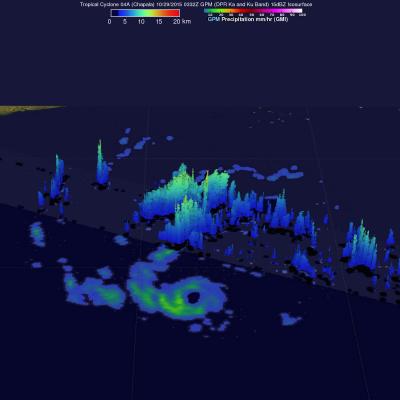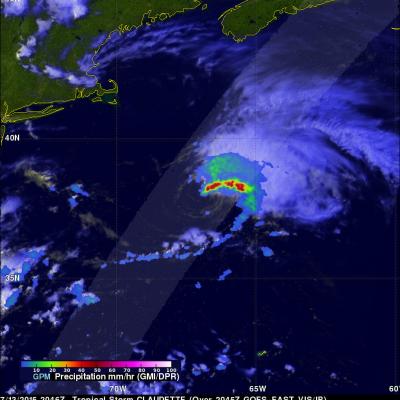DPR
PPS received replacement GPM Ka/Ku L1B products from JAXA and will reprocess the affected data including Level 2 and 3 data. If you have already obtained products with orbit# 20566 from our archive or through a standing order, etc., please discard and use the replacement products. PPS has replaced the following GPM Ka/Ku L1B data: GPMCOR_KAR_1710111422_1555_020566_1BS_DAB_05A.h5 GPMCOR_KUR_1710111422_1555_020566_1BS_DUB_05A.h5 PPS will reprocess the affected downstream L2/L3 products shortly. 2AKa 2A.GPM.Ka.V7-20170308.20171011-S142252-E155525.020566.V05A.HDF5 2AKu 2A.GPM.Ku.V7-20170308
PPS Releases GPM V05 DPR L1-L3 and Combined L2- L3 Data
PPS is releasing GPM V05 DPR L1-L3 and Combined L2 and L3 V05 data products today, Wednesday May 17, 2017. This V05 data will be available beginning with May 01, 2017 data and forward. The DPR Level 3 monthly products will be released when validated. Reprocessed V05 DPR and Combined data for March 2014 through April 2017 will take several weeks to complete. This data will appear in PPS's arthurhou archive as we reprocess (6 to 8 weeks - estimated completion time). Registered users can obtain data from: ftp://arthurhou.pps.eosdis.nasa.gov/ and can order this through STORM: https://storm.pps
Replacement GPM Ka/Ku L1B products (2017-03-19) for orbit 17356
PPS received replacement GPM Ka/Ku L1B products from JAXA and will reprocess the affected data. If you have already obtained products with orbit #17356 from our archive or through a standing order, etc., please discard and use the replacement products. PPS has replaced the following GPM Ka/Ku L1B data: GPMCOR_KUR_1703190533_0705_017356_1BS_DUB_04A.h5 GPMCOR_KAR_1703190533_0705_017356_1BS_DAB_04A.h5 ------------------------------------- PPS will reprocess these affected downstream products shortly. 2A.GPM.Ka.V6-20160118.20170319-S053318-E070552.017356.V04A.HDF5 2A.GPM.Ku.V6-20160118.20170319
V04 Processing for GPM Near-Realtime (NRT) is Scheduled to Begin
Late on March 2, 2016, the GPM NRT system will begin using V04 algorithms for: Level 1B GMI Level 1C GMI Level 1 Radar Level 2 Radar Level 2 Combined V04 is the first version that uses GPM as the calibrator for the constellation rather than TRMM. The GPROF database is built using the combined observations. GMI is extremely well calibrated and the brightness temperatures in 1B and 1C are an important improvement over those in V03. V04 also made improved retrievals in the Ku, Ka, and DPR Level 2 products. Combined has also made retrieval improvements in this version. GPROF the algorithm used for
GPM Examines Tropical Cyclone Chapala
Tropical Cyclone Chapala developed in the very warm waters of the Arabian Sea west of India on October 28, 2015. These images show rainfall derived from data collected by GPM's Microwave Imager (GMI) and Dual-Frequency Precipitation Radar (DPR) instruments. The GPM core observatory satellite had good views of the tropical cyclone on October 29, 2015 at 0332 and 1456 UTC. GPM's rainfall from the first pass show that Chapala was close to hurricane intensity with the location of a developing eye clearly shown by GMI. By the second pass Chapala's maximum sustained winds were estimated at 65 kts
GPM Looks At Tropical Storm Claudette
The National Hurricane Center (NHC) issued it's first advisory for tropical storm Claudette on Monday July 13, 2015 at 1PM AST. The GPM core observatory satellite had an outstanding view as it flew above tropical storm Claudette on the early evening of July 13, 2015 at 2046 UTC (4:46 PM EDT). Rainfall measurements were made by GPM’s Microwave Imager (GMI) and Dual-Frequency Precipitation Radar (DPR) instruments. Claudette is a relatively small tropical storm with vertical wind shear dampening future development but GPM found heavy rainfall in some strong thunderstorms. GPM's radar instrument




